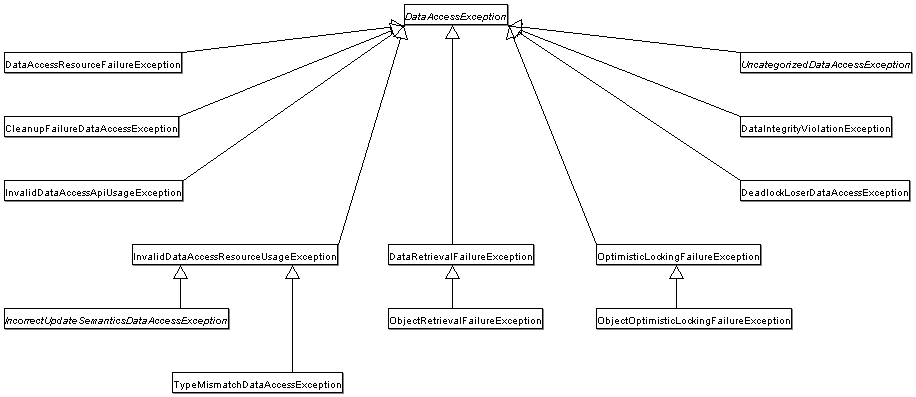

The Data Access Object (DAO) support in Spring is aimed at making it easy to work with data access technologies like JDBC, Hibernate or JDO in a consistent way. This allows one to switch between the aforementioned persistence technologies fairly easily and it also allows one to code without worrying about catching exceptions that are specific to each technology.
Spring provides a convenient translation from technology-specific exceptions like SQLException to its own exception class hierarchy with the DataAccessException as the root exception. These exceptions wrap the original exception so there is never any risk that one might lose any information as to what might have gone wrong.
In addition to JDBC exceptions, Spring can also wrap Hibernate-specific exceptions, converting them from proprietary, checked exceptions (in the case of versions of Hibernate prior to Hibernate 3.0), to a set of focused runtime exceptions (the same is true for JDO and JPA exceptions). This allows one to handle most persistence exceptions, which are non-recoverable, only in the appropriate layers, without having annoying boilerplate catch-and-throw blocks and exception declarations in one's DAOs. (One can still trap and handle exceptions anywhere one needs to though.) As mentioned above, JDBC exceptions (including database-specific dialects) are also converted to the same hierarchy, meaning that one can perform some operations with JDBC within a consistent programming model.
The above holds true for the various template classes in Springs support for various ORM frameworks. If one uses the interceptor-based classes then the application must care about handling HibernateExceptions and JDOExceptions itself, preferably via delegating to SessionFactoryUtils' convertHibernateAccessException(..) or convertJdoAccessException methods respectively. These methods convert the exceptions to ones that are compatible with the exceptions in the org.springframework.dao exception hierarchy. As JDOExceptions are unchecked, they can simply get thrown too, sacrificing generic DAO abstraction in terms of exceptions though.
The exception hierarchy that Spring provides can be seen below. (Please note that the class hierarchy detailed in the image shows only a subset of the entire DataAccessException hierarchy.)

To make it easier to work with a variety of data access technologies such as JDBC, JDO and Hibernate in a consistent way, Spring provides a set of abstract DAO classes that one can extend. These abstract classes have methods for providing the data source and any other configuration settings that are specific to the relevant data-access technology.
JdbcDaoSupport - superclass for JDBC data access objects. Requires a DataSource to be provided; in turn, this class provides a JdbcTemplate instance initialized from the supplied DataSource to subclasses.
HibernateDaoSupport - superclass for Hibernate data access objects. Requires a SessionFactory to be provided; in turn, this class provides a HibernateTemplate instance initialized from the supplied SessionFactory to subclasses. Can alternatively be initialized directly via a HibernateTemplate, to reuse the latters settings like SessionFactory, flush mode, exception translator, and so forth.
JdoDaoSupport - super class for JDO data access objects. Requires a PersistenceManagerFactory to be provided; in turn, this class provides a JdoTemplate instance initialized from the supplied PersistenceManagerFactory to subclasses.
JpaDaoSupport - super class for JPA data access objects. Requires a EntityManagerFactory to be provided; in turn, this class provides a JpaTemplate instance initialized from the supplied EntityManagerFactory to subclasses.